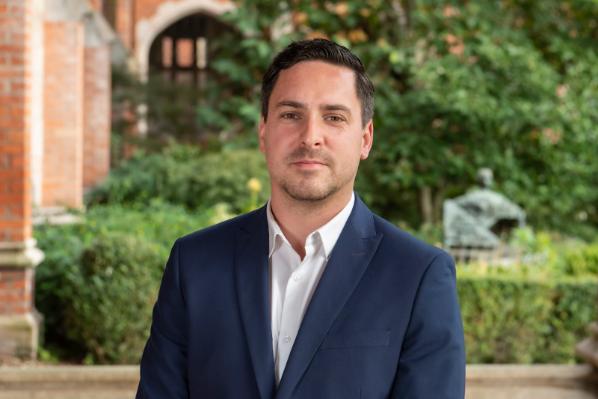BLOG: Queen's Business School Student Hub at Riddel Hall
“Our new building will be a place to bring people together – students, staff, business, and the community. It promises to be a vibrant hub for making new connections.”

A blog by Nathan Campbell – Estates Manager (Sustainable Construction)
I joined the University towards the end of 2022 to take up a new role as Estates Manager (Sustainable Construction), segueing from a consultancy background in Architecture, Building Information Modelling (BIM) and Passive House Design. I was excited to begin work in the University under the ‘storm clouds’ of the Climate Emergency. This position was not only ‘new to me’ but ‘new to the University’ with the ‘sustainable construction’ element relating to the University’s Net Zero aspirations toward tackling Climate Change. From my perspective, the introduction of this new post demonstrated that Queen’s was committing to driving change and working towards a transition to a Net Zero University.
So, what is Net Zero and why is the University committed to this target? The Energy Saving Trust define Net Zero as “achieving a balance between the carbon emitted into the atmosphere, and the carbon removed from it”. In essence, climate change is a by-product of our carbon emitting behaviours; to limit the impacts of climate change (limiting global temperature rise to 1.5°C), there is an urgency to transition to a net zero society. Given the University’s reputation and responsibility as a leading educational institution, it aspires to be pioneer in research and development whilst acting as a catalyst for progress at pace within Northern Ireland and further afield.
Fast forward nearly a year now, I’ve been privileged to have been involved in several commendable projects at Queen’s such as the ‘Belfast Region City Deal’ (BRCD) projects (AMIC, GII and IREACH), new purpose-built student accommodation on the Dublin Road (Passive House) and the new Queen's Business School Student Hub at Riddel Hall.
Focusing on the latter, the project is on track to achieve BREEAM1 ‘Excellent’; an accreditation that targets a diverse range of sustainability topics that can assist in progressing towards Net Zero. Topics such as Energy, Transport, Water, Materials, Waste, Land Use and Ecology and Pollution. Achieving this accreditation goes some way to constructing a ‘sustainable’ building.
Even withstanding this achievement, the University has pushed the limits of project brief to enhance the building, site and wider environment. It is deceptively restrained and low key, but with further investigation it is clear that this is not just another building, insofar as it is one of a limited number of buildings of this scale and complexity to be heated solely by geothermal energy. Hidden beneath the manicured lawn in front of the existing red-brick Riddel Hall building, 38 boreholes have been driven to a depth of 120m into the underlying Sherwood Sandstone, the system extracts the geothermal energy to supply the building with a renewable heat source. This renewable energy source is relatively low-tech but has potential to provide a pragmatic pathway to net zero, but surprisingly is underutilised in NI. Without exaggeration, this is somewhat pioneering in the industry, something we should be proud of within the University. In carbon terms, this could provide a massive 61 per cent reduction in carbon emissions from 120 tonnes to 46 tonnes. We will keep you posted!
Maintaining the existing qualities of the Riddel Hall site was key from both a university and statutory approval perspective but it was also important to enhance what qualities already existed. Biodiversity therefore was an important consideration, insofar as the design ‘nestled’ the new building around existing trees, minimised impact on ecology and develops a greater offering for ecology through wildflower roofs and integral ‘swift boxes’ with calling system within the building’s façade.
In reflection on the achievements above, I am optimistic that staff and students will be supported through this new facility to build upon their progress to date through sustainable thinking and behaviours. The new Riddel Hall was constructed to provide a backdrop for academic studies but it provides so much more for the University in terms of ‘raising the bar’ in the estate and working at pace to disrupt climate change.
I will stop there before I begin to write about the interior (which could take some time), however I encourage you to arrange a site visit and investigate for yourself.
1 BREEAM: Building Research Establishment Environmental Assessment Method
